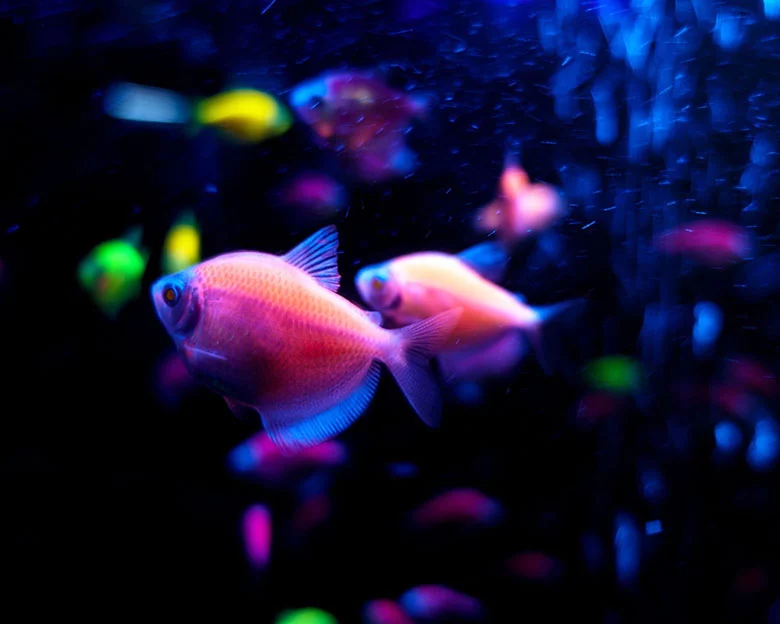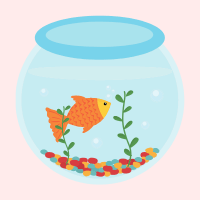Are you looking for a unique and vibrant addition to your aquarium, specifically for Glofish Care? Look no further than GloFish!
These genetically modified fish are sure to catch your eye with their bright and bold colors. But don’t worry, these fish are not injected or dyed with fluorescent dye like their painted predecessors. Instead, their genes have been manipulated to produce their stunning hues.
Not only are GloFish visually appealing, but they are also easy to care for, making them a great choice for beginners. They are hardy and undemanding fish that require basic care and maintenance.
In this article, we will explore the world of GloFish, from their genetic modification and fluorescence to their feeding and tank requirements. Whether you’re a seasoned aquarium enthusiast or just starting out, GloFish are a must-have for any aquarium lover looking for a colorful and low-maintenance addition to their tank.
Key Takeaways
- GloFish are genetically modified organisms that have been manipulated to have bright colors using a patented method.
- There are several species of GloFish, including danios, barbs, tetras, sharks, and bettas, each with their own specific care requirements.
- GloFish are hardy and easy to care for, making them a great choice for beginner aquarists.
- GloFish tanks should be at least 20 gallons and decorated with cool decor that reacts to blue aquarium lights to enhance their fluorescent colors.
Genetic Modification and Fluorescence

You already know that GloFish are genetically modified organisms (GMO) that have been manipulated to have bright colors and can fluoresce under blue aquarium lights. This has led to some controversy in the aquarium hobby community due to concerns about genetic engineering and the potential impact on aquatic biodiversity.
However, it’s important to note that GloFish are not injected or dyed with fluorescent dye like the ‘painted‘ fish of the past. The genetic modification process for GloFish involves introducing a naturally occurring fluorescence gene from another organism into the fish’s genome.
This results in the fish’s skin absorbing light energy and emitting it back, creating a beautiful and unique visual effect. While there are debates about the ethics and safety of genetically modifying organisms, GloFish have been thoroughly tested and approved by regulatory agencies for both human and environmental safety.
GloFish Species and Grouping
Immerse yourself in a world of vibrant and diverse aquatic life by grouping GloFish species together, creating a stunning display that will make your aquarium the envy of all your friends. However, it’s important to consider compatibility concerns when selecting GloFish species for your tank.
Firstly, GloFish danios are great companions for GloFish tetras, as they have similar temperaments and thrive in groups of at least five. On the other hand, GloFish barbs can be nippy with other species and should only be kept with other active fish that can hold their own.
GloFish sharks are territorial and may not tolerate other bottom-dwelling fish, so keeping them with other larger, semi-aggressive species is best. Furthermore, while GloFish are derived from hardy species, keeping them in groups to reduce stress and promote natural behavior is important.
In terms of breeding possibilities, GloFish can breed with their non-genetically modified counterparts, but their offspring will not fluoresce. It’s also important to note that GloFish are patented and should not be bred for commercial purposes without the proper licensing.
However, breeding GloFish can still be a fun and educational experience for hobbyists. With proper research and planning, creating a harmonious GloFish community in your aquarium can be a rewarding and visually stunning experience.
Feeding and Tank Requirements
To ensure the health of your aquatic pets, it’s recommended to provide a tank of at least 20 gallons and decorate it with items that will react to blue aquarium lights. This will give your GloFish a comfortable and stimulating environment and enhance their vibrant colors. When setting up your tank, make sure to include hiding places and plants for your fish to explore and feel secure. Maintaining good water quality by performing regular water changes and using a reliable filtration system is also important.
Feeding tips for GloFish are fairly simple. They readily accept flake, pelleted, or frozen foods, but it’s best to provide a high-quality, commercially prepared pellet as their staple diet. You can also give them freeze-dried bloodworms or brine shrimp as a treat. Ensure not to overfeed your fish, which can lead to health problems and poor water quality. A good rule of thumb is to feed them small amounts twice a day, only giving them what they can consume within a few minutes. With these feeding tips and tank setup ideas, you’ll be able to provide a happy and healthy home for your GloFish.
| Feeding Tips | Tank Setup Ideas |
|---|---|
| Provide a high-quality, commercially prepared pellet as their staple diet | Include hiding places and plants for your fish to explore and feel secure |
| Give them freeze-dried bloodworms or brine shrimp as a treat | Maintain good water quality by performing regular water changes and using a reliable filtration system |
| Feed them small amounts twice a day, only giving them what they can consume within a few minutes | Decorate your tank with items that will react to blue aquarium lights to enhance their vibrant colors |
Benefits and Considerations
It’s absolutely worth considering the benefits and drawbacks of adding genetically modified fish to your home aquarium.
On the one hand, GloFish are undeniably eye-catching and can add a unique pop of color to your tank. They are also hardy and easy to care for, making them a great choice for beginners. Additionally, they can be a great addition to a community tank, as they are generally peaceful and get along well with other species.
However, there are also some potential drawbacks to consider. First and foremost, there are ethical concerns surrounding the genetic modification of animals for purely aesthetic purposes. Some people argue that it is wrong to manipulate the genes of living creatures simply to make them look more attractive. Additionally, there is the risk of unintentionally introducing GloFish into the wild, where they could potentially outcompete native species or disrupt ecosystems.
Ultimately, whether or not to add GloFish to your aquarium is a personal decision that should be made after carefully weighing the pros and cons.
Frequently Asked Questions
Are Glofish Safe To Keep With Other Fish In A Community Tank?
When considering Glofish compatibility, keeping them with fish with similar temperaments and requirements is important. Glofish are peaceful and easy-going, making them great tank mates for other community fish in a well-maintained aquarium.
Can Glofish Be Bred In Captivity?
Breeding techniques for GloFish involve selectively breeding individuals with desired traits, such as bright colors. Genetic modification controversies surround GloFish, but they are safe for consumption and pose no threat to the environment.
Do Glofish Require Special Lighting Or Filtration?
Yes, GloFish requires LED lighting to make their bright colors fluoresce. Efficient filtration is also necessary to maintain water quality in their 20 gallon tanks. Both are crucial for the health and vibrancy of these unique genetically modified fish.
Are There Any Potential Health Risks Associated With Keeping Glofish?
Keeping GloFish may pose potential health risks to both the fish and the environment. The modified genes in these fish could spread to wild populations if released. GloFish may also carry diseases that can be harmful to other fish in the tank.
What Is The Lifespan Of A Glofish?
The lifespan of a GloFish varies depending on the species, but they typically live for 3-5 years. Breeding techniques for GloFish involve using hormone injections to induce spawning. It’s important to provide proper care to extend their lifespan.
Add a Splash of Color and Excitement to Your Aquarium with GloFish!
Now that you’ve learned about the fascinating world of GloFish, it’s time to incorporate them into your aquarium. Imagine the vibrant colors of the fish illuminating your tank, creating a stunning and unique display that will leave your guests in awe.
With their hardiness and undemanding nature, caring for GloFish is a breeze. This allows you to enjoy their beauty without the stress of constant maintenance. Picture yourself sitting in front of your aquarium, watching as the GloFish dart around, their colors radiating in the light.
You’ll feel at ease, relaxed, and mesmerized by the stunning display in front of you. So why not add some color and excitement to your aquarium with GloFish? They are sure to be a must-have for any aquarium enthusiast looking for a low-maintenance but high-impact addition to their collection.

